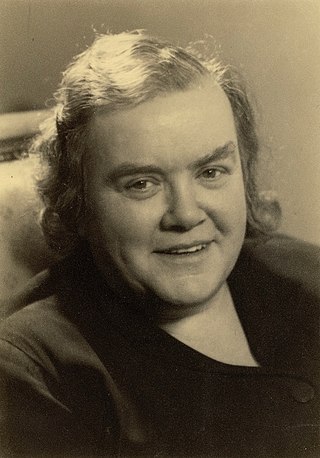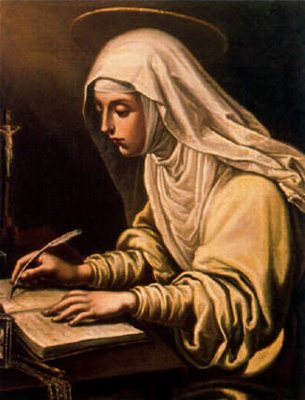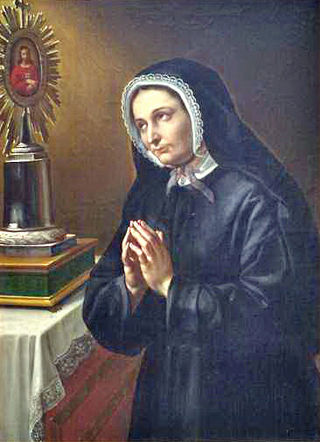
St. John of the Cross was a Spanish Catholic priest, mystic, and Carmelite friar of converso origin. He is a major figure of the Counter-Reformation in Spain, and he is one of the thirty-seven Doctors of the Church.

The Bridgettines, or Birgittines, formally known as the Order of the Most Holy Saviour, is a monastic religious order of the Catholic Church founded by Saint Birgitta in 1344 and approved by Pope Urban V in 1370. They follow the Rule of Saint Augustine. There are today several different branches of Bridgettines.

Luisa Carvajal y Mendoza is best known for her mystical religious poetry as well as her fight to spread Catholicism throughout England, by preaching against Anglicanism. She was imprisoned on two occasions, once in 1608 and again in 1613 for her Catholic proselytizing activities in England. Although her cause of death makes her ineligible to be considered a martyr, she took a vow for martyrdom in 1598.

Joanna of Austria was Princess of Portugal by marriage to João Manuel, Prince of Portugal. She served as regent of Spain for her brother Philip II during his trips to England to marry Mary I from 1554 to 1556, and 1556 to 1559. She was the mother of King Sebastian of Portugal.
Magdalena de la Cruz (1487–1560) was a Franciscan nun of Córdoba in Spain, who for many years was honored as a living saint. However, St. Ignatius Loyola had always regarded her with suspicion. Falling dangerously ill in 1543, Magdalena confessed that her stigmata and claims of performing miracles were fraudulent. She was sentenced by the Inquisition, in an auto-da-fé at Córdoba in 1546, to perpetual imprisonment in a convent of her order, and there she is believed to have ended her days most piously amid marks of the sincerest repentance.

Antonio Escobar y Mendoza was a Jesuit priest and prominent ethicist of his time.

Ignacia de Loyola de Palacio y del Valle Lersundi was a Spanish politician. She was among the first women to rise to political prominence in Spain during the early years of reconstituted democracy. She was a minister in the Spanish government from 1996 to 1998, and a member of the European Commission from 1999 to 2004.

Adrienne von Speyr was a Swiss Catholic convert, physician, mystic, and author of some sixty books of spirituality and theology.

Luis de la Puente was a Spanish Jesuit theologian and ascetic writer. He was one of the most esteemed ascetical writer of the seventeenth and eighteenth centuries. A few years after his death, the Sacred Congregation of Rites admitted the cause of his beatification and canonization.

Cándida María de Jesús, born in Andoain, as Juana Josefa Cipitria y Barriola, was a Spanish nun and the founder of the Daughters of Jesus. The order – founded in 1871 – was under Jesuit direction from her spiritual director and was involved with the education of children in Salamanca though expanded during her lifetime.

Ignatius of Loyola, venerated as Saint Ignatius of Loyola, was a Basque Spaniard Catholic priest and theologian, who, with six companions, founded the religious order of the Society of Jesus (Jesuits), and became its first Superior General, in Paris in 1541.

Catherine de' Ricci, OP, was an Italian Catholic nun in the Third Order of St. Dominic. She is believed to have had miraculous visions and corporeal encounters with Jesus Christ. She is also said to have spontaneously bled with the wounds of the crucified Christ. She is venerated for her mystic visions and is venerated as a saint by the Catholic Church.
Isabella Roser was a sixteenth-century Catalan noble woman of Barcelona who helped Ignatius of Loyola and sponsored him, when, on returning from Jerusalem, the 30-year-old pilgrim wished to start anew his schooling. She later demanded membership of the Jesuits for herself and two female companions. Although this was initially granted it was rescinded and the order has remained open only to males ever since.

Teresa de Jesús is a Spanish television mini-series produced by Televisión Española and broadcast in its Primera Cadena in 1984. Directed by Josefina Molina and written by Víctor García de la Concha, Carmen Martín Gaite and Molina herself, it stars Concha Velasco as Teresa of Avila.
Michael Walpole (1570–1624?), was an English Jesuit and controversialist.

Elisabetta Canori Mora was an Italian member of the Third Order of the Most Holy Trinity. Mora married an abrasive husband who remained unfaithful and abusive to her but at the time of her death secured his repentance, and he became a priest. Mora had a range of spiritual experiences in which she heard the voice of God and visions of the Madonna and other saints while also experiencing religious ecstasies during her life.

The Iglesia de la Compañía de Jesús is a historic Jesuit church in Cusco, the ancient capital of the Inca Empire, in Cusco Region, Peru. It is situated in the Plaza de Armas de Cusco, the city center. It is built on an Inca palace. It is one of the best examples of Spanish Baroque architecture in Peru. The architecture of this building exerted a great influence on the development of many Baroque architecture in the South Andes. Its construction began in 1576, but it was badly damaged in an earthquake in 1650. The rebuilt church was completed in 1673.

The Church and Convent of San Ignacio de Loyola de la Compañía de Jesús de Quito, also known in the Ecuadorian people simply as La Compañía, is a Catholic clerical complex located on the corner formed by calles García Moreno and Sucre, in the Historic Center of the city of Quito, capital of Ecuador. The façade of its main temple is entirely carved in volcanic stone. Over time, this church has also been called: "Temple of Solomon of South America". Father Bernardo Recio, a traveling Jesuit, called it "Golden Ember".

Familia moderna is a Chilean television series based on the American sitcom Modern Family which aired on ABC. It is produced and broadcast by Mega since December 3, 2015, starring Patricio Contreras, Mariana Loyola, Nicolás Saavedra and Álvaro Escobar in the lead roles.

Madre Cecilia del Nacimiento (OCD) was a Spanish nun, mystic, writer, and poet influenced by the Carmelites, of which she became prioress. A Discalced Carmelite and abbess, her work is written in verse and prose and, mainly, it is a mystical production, based on her spiritual experiences. Her production included Romance (poesía), a type of poem characteristic of the Spanish, Iberian, and Latin American literary tradition, glosses, Christmas carols, redondilla, limericks, and theatrical work within the convent. Both Cecilia and her older sister, Madre María Sobrino Morillas, copyists and archivists of manuscripts in their convent.


















